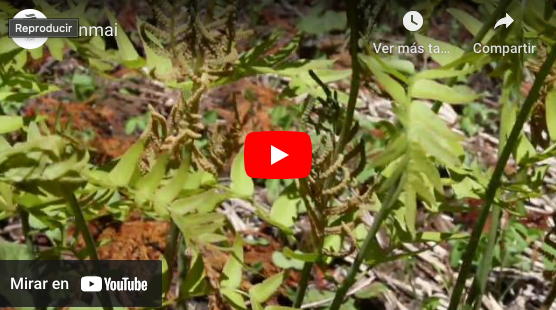As I spend time in Japan, I realize how much I have already covered in our blog in regards to tenkara. This blog has a wealth of information regarding tenkara, unmatched anywhere. Yesterday a local reporter came to speak to me about tenkara as he's helping put together some type of museum of fishing . I started bringing up all these things that he wasn't aware of, and pulled my computer to show him what I was talking about. Among these posts was one about the use of the Zenmai Fern dubbing material on some old flies. It seems like I'm too late to collect zenmai fern in this area (they came up in early March this year), but I thought some of you may have not read this post before and may be interested in reading it.
Originally posted on June 16, 2010 after my last year's visit to Japan.
ZENMAI
I love the idea of using natural materials on all my flies. Through tenkara I learned about a material most people accustomed to the western fly-tying traditions have never heard of and very few have used, even though its properties make it a great material and it's available in most parts of the world, including the US: the zenmai.
The zenmai was first introduced to me by Fujioka sensei, my teacher of tenkara flies, through his excellent. A few months ago he sent me some flies, and also a small bit of zenmai, which I would not dare use as they belong to the "museum". While fishing with Fujioka sensei, I asked if he had seen any zenmai around, "it's a bit too late in the season", he replied. Usually the zenmai comes out in very early spring and the fleece falls off soon after. However, as luck would have it, Fujioka sensei later went to an onsen (hot springs) at a higher elevation and there he was able to find some.
The zenmai is a type of fern that, in early spring, has a cotton-like material on its body. This cotton-like material makes for excellent dubbing material, it is relatively waterproof, and can be easily made into a tight thread. Depending on the time it is picked or the plant it is picked from, the zenmai will vary slightly in color, with some being darker, and more commonly found in a light tan color.
Usually referred to as "flowering fern", the zenmai belongs to the Osmunda family. The Japanese species is the Osmunda japonica, but according to Fujioka sensei the zenmai may be found worldwide, except for Australasia. The plant can be found in two stages with fleece still on its body: more commonly it's found as a fiddlehead fern, a young shoot coming out of the ground and still curled up with fleece covering it almost entirely. Or, as a grown plant with the fleece material still on its stems, like in this video.
Though a bit hard to find at this time of year, there were still a few plants around during my visit (late May-early June). The day after Fujioka sensei gave me some zenmai, I found one plant with the fleece still attached to its body. The following week, as I visited my wife's grandparents farther north in Yamagata, they found some more zenmai stalks while picking sansai (mountain vegetables). That's another cool thing about this plant, the Japanese zenmai is an edible plant, a sansai, which is commonly picked by people in the mountains areas of Japan. The cotton-like material is discarded, and the meaty vegetable prepared and eaten. On this day, vegetable picking proved to be more productive than fishing (the water was too cold, I believe). Among a couple of enormous bags we picked of warabi, and fuki were a few young fiddlehead ferns still fully covered in zenmai fleece.
After being dried for a while, the zenmai can be prepared as a delicious mountain vegetable. We had some awesome meals with these on the side.
I know some tenkara anglers in the US have already picked North American zenmai this year, for their own flies. But, I'm afraid this post may be too late for most people to be able to find it now.
